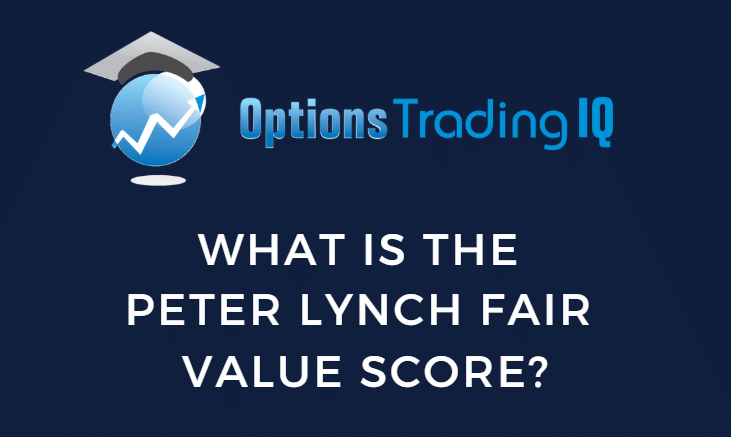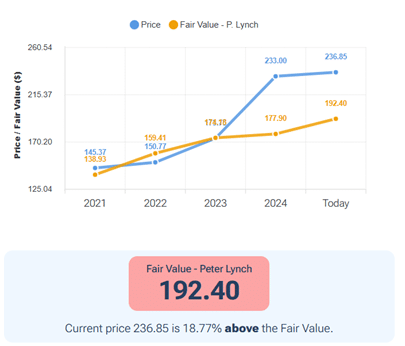
Whereas Peter Lynch didn’t coin nor particularly use this metric for evaluating the worth of an organization, it bought this title as a result of others have created this quantitative measure based mostly on his funding rules.
Peter Lynch is a well known profitable investor and the previous supervisor of the Constancy Magellan Fund.
His funding rules are to know the corporate’s fundamentals of a enterprise and its development potential.
He favored firms with constant and sustainable earnings development, ideally within the vary of 20-25% yearly for fast-growing firms.
Particularly, the Peter Lynch Valuation Rating facilities across the PEG ratio.
Contents
Earlier than we get to the PEG ratio, first, let’s evaluation the P/E ratio.
The P/E ratio is the ratio of the inventory’s worth per share to its earnings per share.
PE ratio = Worth per share / Earnings per share
If the value is excessive in relation to its earnings, it has a excessive P/E ratio, suggesting that the inventory could also be overpriced or above truthful worth.
If the value is low in relation to its earnings, it has a low P/E ratio, suggesting that the inventory could also be undervalued.
Whether or not the P/E ratio is taken into account “excessive” or “low” is relative.
It’s relative to the inventory’s historic P/E and in addition to its trade friends.
It’s regular for sure shares and industries to have the next P/E ratio than different shares and industries.
Peter Lynch, being a worth investor, likes undervalued shares.
He additionally takes into consideration the corporate’s development charge.
The PEG ratio captures this.
This price-to-earnings-to-growth ratio is the P/E ratio divided by the incomes development charge.
PEG = worth per share / Earnings per share / Earnings Progress Fee
If the P/E ratio of a inventory is low (which means undervalued) whereas its incomes development charge is excessive, then it can end in a decrease PEG ratio, which is what Peter likes.
Entry The High 5 Instruments For Choice Merchants
We are able to rearrange the above system to get the value per share:
Honest Worth (Worth per share) = Earnings Progress Fee * Earnings per share * PEG
Though some truthful worth fashions prefer to say that an organization is pretty priced when its PEG is 1, that is unrealistic for sure firms and industries that are inclined to have a traditionally excessive PEG.
It might take a very long time to attend for the value per share to say no to that “truthful worth” the place PEG = 1.
Subsequently, different truthful worth fashions like to think about the businesses/industries’ historic PEG when calculating truthful worth.
We’ve simply given you a normal primary intuitive understanding of how the Peter Lynch Honest Worth Rating is calculated.
The precise calculation and modeling get extra sophisticated as they contain varied nuances, reminiscent of whether or not it’s primary EPS or diluted EPS.
Do the earnings embrace or exclude non-recurring objects (NRI)?
What timeframe is taken into account?
Is it trailing twelve months (TTM) or ahead EPS?
Is EBITDA getting used or not?
That’s “Earnings Earlier than Curiosity, Taxes, Depreciation, and Amortization”.
And so forth.
Subsequently, it isn’t so simple as wanting up a quantity and plugging it right into a calculator.
It’s best to depart it as much as the monetary gurus and on-line truthful worth fashions.
For example, one such mannequin of utilizing Peter Lynch Valuation may be discovered on forecaster.biz:

Supply: forecaster.biz
It offers the Peter Lynch truthful worth worth per share and charts it out over time in relation to the precise inventory’s worth.
This instance reveals that this inventory is at present priced above the Peter Lynch truthful worth rating, suggesting that the value could also be overvalued.
We hope you loved this text on the Peter Lynch valuation rating.
You probably have any questions, please ship an electronic mail or depart a remark beneath.
Commerce secure!
Disclaimer: The data above is for academic functions solely and shouldn’t be handled as funding recommendation. The technique introduced wouldn’t be appropriate for traders who are usually not conversant in trade traded choices. Any readers on this technique ought to do their very own analysis and search recommendation from a licensed monetary adviser.







